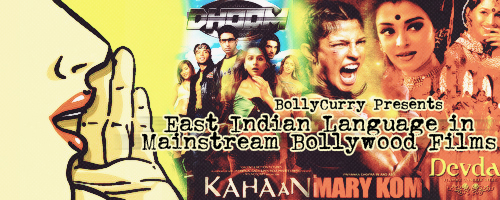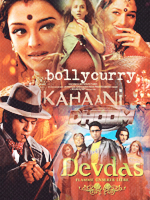- Home
- News
- Talk Round' Town
- East Indian Language in Mainstream Bollywood Films
East Indian Language in Mainstream Bollywood Films
 Comments [ 1 ] By Gurprit K. | 08 June 2015 | 9:35pm
Comments [ 1 ] By Gurprit K. | 08 June 2015 | 9:35pm

The fact that Bollywood is a fancy name for the Hindi film industry has never restrained the fraternity from including numerous non-Hindi facets in its movies, be it in the form of dialogues, songs, or artistes from such regions.This week, BollyCurry reviews the use of varied East Indian languages in Bollywood films and explores the few attempts made to integrate this not-so-familiar part of Indian culture into the massively popular mainstream Hindi movies.
The Bong Factor
 The
rich literary heritage of the language was a major factor that helped
Bengali language rise to the forefront of Eastern influences, with the
Sarat Chandra Chattopadhyay novel 'Devdas' being the one in the
limelight. The most recent adaptation of this timeless classic onto the
silver screen, Devdas (2002) used Bengali sparingly. This was a
given, as the use of extensive subtitles may have ruined the viewing
experience for the common audience. The next popular movie that had
dialogues from the region, was Dhoom (2004), in which we had the
Bengali lass Sweety (Rimi Sen) bursting into her mother tongue every
time she got agitated or angry at her husband Jai (Abhishek Bachchan).
Though this was not an "artistic" use in any way, her sequences do
remain memorable amongst the viewers. A film in more recent times which
beautifully captured the cultural nuances of the language was the Vidya
Balan starrer Kahaani (2012). It depicted the not-so-subtle
differences in the pronunciation of Bengali speakers, from the
protagonist Vidya Bagchi's (Vidya Balan) viewpoint, who played an
outsider to the culture. With many more movies about to be released set
in the region, Bengali is bound to remain the most important Eastern
influence in Hindi films.
The
rich literary heritage of the language was a major factor that helped
Bengali language rise to the forefront of Eastern influences, with the
Sarat Chandra Chattopadhyay novel 'Devdas' being the one in the
limelight. The most recent adaptation of this timeless classic onto the
silver screen, Devdas (2002) used Bengali sparingly. This was a
given, as the use of extensive subtitles may have ruined the viewing
experience for the common audience. The next popular movie that had
dialogues from the region, was Dhoom (2004), in which we had the
Bengali lass Sweety (Rimi Sen) bursting into her mother tongue every
time she got agitated or angry at her husband Jai (Abhishek Bachchan).
Though this was not an "artistic" use in any way, her sequences do
remain memorable amongst the viewers. A film in more recent times which
beautifully captured the cultural nuances of the language was the Vidya
Balan starrer Kahaani (2012). It depicted the not-so-subtle
differences in the pronunciation of Bengali speakers, from the
protagonist Vidya Bagchi's (Vidya Balan) viewpoint, who played an
outsider to the culture. With many more movies about to be released set
in the region, Bengali is bound to remain the most important Eastern
influence in Hindi films.The "Others"
 The very fact
that apart from Bengali, not many languages from the East has had a
minimum presence in Bollywood movies emphasizes that a lot more needs to
be done in the future. There have been attempts made in this direction,
the most prominent being last year's biopic Mary Kom (2014),
where quite a few terms and pronunciations were borrowed from the
Manipuri language. A Manipuri term of endearment, "Thoi" was used
throughout the movie by the male lead, which enhanced the authenticity
of the movie. Also for the first time in Hindi cinema, a lullaby
"Chaoro" with Manipuri or Meithei lyrics, as the language is known, was
also featured. The movie went on to win National Award for the Best
Popular Film of 2014 and this should assuage any fear the film makers
have regarding the effect of the using an unfamiliar language on a
film's marketability.
The very fact
that apart from Bengali, not many languages from the East has had a
minimum presence in Bollywood movies emphasizes that a lot more needs to
be done in the future. There have been attempts made in this direction,
the most prominent being last year's biopic Mary Kom (2014),
where quite a few terms and pronunciations were borrowed from the
Manipuri language. A Manipuri term of endearment, "Thoi" was used
throughout the movie by the male lead, which enhanced the authenticity
of the movie. Also for the first time in Hindi cinema, a lullaby
"Chaoro" with Manipuri or Meithei lyrics, as the language is known, was
also featured. The movie went on to win National Award for the Best
Popular Film of 2014 and this should assuage any fear the film makers
have regarding the effect of the using an unfamiliar language on a
film's marketability.Though many popular movies have had
portions set in the East, such as "Dil Se" (1998), the industry has
always refrained from shooting in actual locations or using any of the
local language in their films. This trend ought to change and if so, it
can lend the people of the region a sense of inclusion as well as help
those in the other parts of the world learn more about the indigenous
culture and their way of life. Bollywood, as a popular medium, has the
moral responsibility to ensure that this is realized. We would love to
hear your thoughts on the use of the languages from orient India in
Hindi movies. Do comment below and let us know!
Author: Aishwarya S.
Editor/s: Ritchelle C. and Hershi J.
Graphics: Shikha A.
Editor/s: Ritchelle C. and Hershi J.
Graphics: Shikha A.
Do you have a suggestion or comment for BollyCurry? Drop us a PM at BC_Dropbox today.
Copyright BollyCurry
User Rating  (6 Votes)
(6 Votes)
Views 3218
User Comments

If You are a member of India-forums, Then You can also log in here.
Related Videos
- Sonam And Anand's Grand ...
- Vidya Balan comes as a ...
- In conversation with ...
- Rochelle is a player : ...
- Rochelle is a player : ...
- Who is the promising ...
Highlights Zone
- Shah Rukh Khan to make his DEBUT in a Tamil movie as a VILLAIN?
- Abhishek spends pool time with Aishwarya, Aaradhya
- Abhishek posts a ROMANTIC still with Aishwarya on their ANNIVERSARY
- Multi-starrer movies: An evergreen money-making trend
- Aishwarya, Abhishek give vacay goals with Maldives trip
- PHOTO: Inside Aishwarya-Abhishek-Aaradhya's exotic MALDIVES holiday
- The break was good for my craft: Aditya Roy Kapur
- #FilmyFriday: Why entertainment factor degraded in Golmaal franchise?
 5
5 - Saiyami Kher to star in 'Breathe' season two
- Vidya Balan praises Zoya Akhtar for her recent release Gully Boy!









